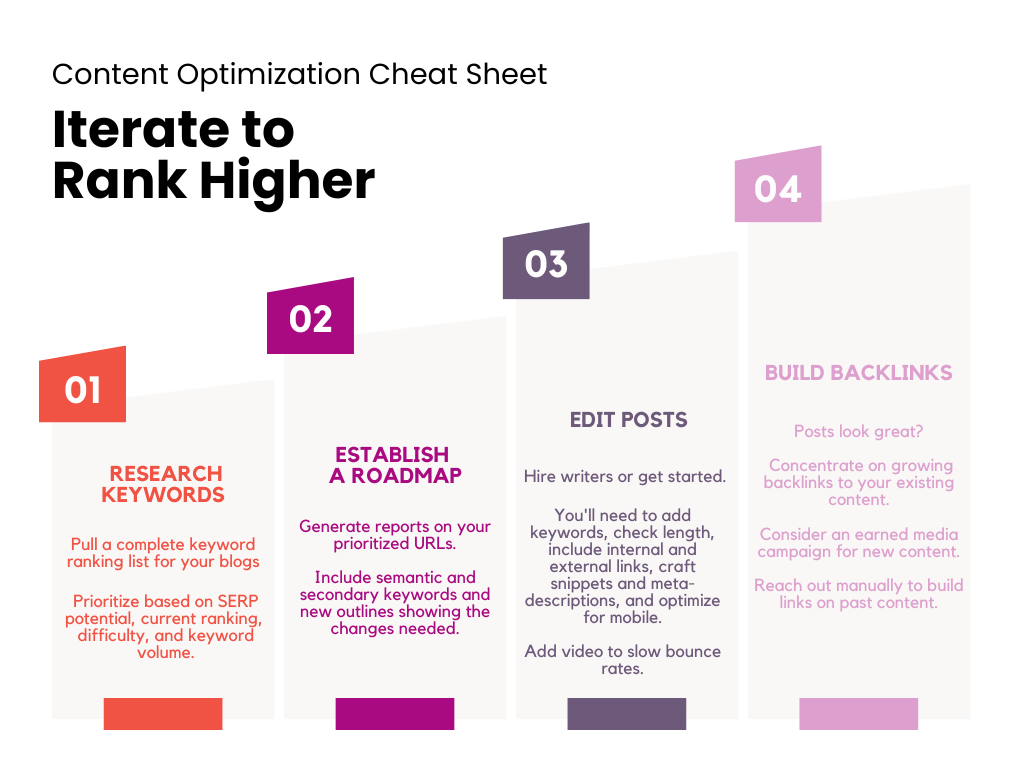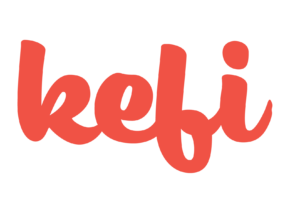How do you optimize SaaS content? The “right” answer depends on your content calendar and how long you’ve been posting. Here’s the basic 4-step process that every company needs to follow to get its content in top shape every quarter. This is the process we use for clients to identify the best opportunities, prioritize them, and take actionable steps to rank higher.
An SEO strategy without an SEO Optimization Strategy is like dessert without chocolate. You can do it. You might even get something out of it. But you’re leaving a lot on the table. Let’s review how Kefi optimizes content for our SEO clients.
Here’s our playbook for how to give your content the kefi it deserves.

Step One: Research Keywords
We pull a report on our ranking keywords for our entire site using your SEO monitoring software, like AHrefs. We want to know what we currently rank for. You have a couple of choices:
- You can look at the content you created 2 quarters before, ensuring you catch high-potential articles and give them a boost as quickly as possible.
- You can look at your content as a whole, prioritizing which content to improve based on overall priorities and not letting content go to the content graveyard if it’s showing potential at any time in its lifecycle.
The benefit of an all-encompassing audit is that you’ll see keywords rising or falling from the rankings much longer and more holistically than if you optimize right after publishing, then forget the rest of your site.
However, you’ll also see core pages cropping up again and again. You’ll repeat some work investigating whether these sites are worth your time when in reality, they’re still sitting behind a herd of authoritative posts. You could also neglect spotting key trends with your newest ranking content.
Whichever you choose, you should generate a list of blogs and their rankings for primary keywords.
How many are ranking between 2 and 25 in the SERPs?
Start there. Have too many high-potential posts? Sort them by looking at:
- The SERP potential of your article. Look at the page 1 contenders on those SERPs. If the top spots all go to long-established players with high DA and gobs of backlinks, spend your time on other articles.
- The difficulty you’ll have ranking. What’s your website’s domain authority (DA)? How many of these keywords can you potentially dominate?
- Your current ranking. If you’re 2nd right now, prioritize making your article first!
- The keyword volume. Prioritize higher volume keywords over lower.
Add optimization tasks across your content calendar for the coming quarter and repeat the process next quarter.
Step Two: Establish a Roadmap
Once you know which articles you’ll optimize, you’ll need to figure out what you want to do to them. We use SEO tools for this step, just like we did when pulling our top-performing keywords. You can use a Frase report (an SEO outline, brief, and blog-building tool). It can help you generate new briefs that take new SERPs into account, helping you optimize and update older content to keep it relevant for your audience.
You can also use an SEO tool like LowFruits. It claims to help users find “easy” keywords, but it also helps you chip away at difficult keywords. Think about building better cluster content around your core topics as part of your new content calendar in the upcoming months. Or linking older content to those “easier” keywords to tell Google you’re an authority on all the related topics.
We produce a new content brief, including:
- A list of secondary keywords and semantic keywords a post needs
- Common questions asked and answered in similar articles
- Common statistics and external authorities cited by other top SERPs
- Suggested headers and the number of headers needed to rank
- Suggested word count needed to rank
Because adding all the same content the top results already have feels pointless (and because it’s not so great), we add some statistics, talk to an SME, or put together a graphic. Any extra tactic to improve your content and give more value to your audience helps keep your content fresh and help it rank with high engagement.
Step Three: Rewrite and Edit Posts
Add all the components you need to make your post even more fabulous than the ones that currently top the SERPs. Add headers you’re missing, title and meta description tags, and primary and secondary keywords you can add. You’ll also want to:
- Add words. Aim for 1,500-2,000 words or the suggested word count that your keyword tool suggests.
- Reduce your bounce rate with valuable, engaging content on your post. Video, maybe? What about an illustration or comic strip explaining a topic? That could also set you up for a Google Images ranking.
- Optimize links. Do you have a logical internal link structure? Are you linking to your other content in this topic cluster? Are you linking to high-authority, external sources?
- Optimize for search intent. Go deep into what searchers are likely looking for when they land on your page. Give them more of what they want.
- Break up paragraphs for mobile. Make content skimmable, readable, and easy to digest, no matter the device.
Step Four: Consider Links
If your content looks great and you’re still not topping the rankings, consider an external link campaign to float your domain authority. That can include manually reaching out for links on existing content or drawing new traffic and domain authority to your site through earned link campaigns as part of the new content you’re creating.
Let Kefi Do the Heavy Lifting
Like cleaning a room until it sparkles, there’s a special kind of satisfaction that comes from polishing up content until it’s performing its best. To free your time for high-value business activities, let Kefi optimize your site. We’ll analyze your ranking keywords, prioritize the best articles to optimize, find out what they need most, then make them shine. You’ll get a rankings boost without creating new content, winning added authority and views. Get on our calendar to talk about it.





